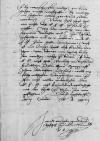List #5202
Ioannes DANTISCUS do Albrecht I von Hohenzollern-AnsbachHeilsberg (Lidzbark Warmiński), 1538-10-23
| odebrano Königsberg (Królewiec), 1538-10-24 Rękopiśmienne podstawy źródłowe:
Pomocnicze podstawy źródłowe:
Publikacje:
| ||||||||
Tekst + aparat krytyczny + komentarz Zwykły tekst Tekst + komentarz Tekst + aparat krytyczny
 GStA, PK, HBA, C 1, No 526, f. 3 unnumbered
GStA, PK, HBA, C 1, No 526, f. 3 unnumbered
Dem durchlauchten(n), hochgebornen(n) fursten(n) und hern, hern
 GStA, PK, HBA, C 1, No 526, f. 1 unnumbered
GStA, PK, HBA, C 1, No 526, f. 1 unnumbered
Durchlauchter, hochgeborner furst, hochgunstiger, lÿber her und freundt. / Unser freuntliche dinst zuvoran. /
Wir haben jestriges thagess E(wer) F(urstlichen) D(urchlauch)t cf.  GStA, PK, HBA, C 1, No 526, f. 2 unnumbered ( so dy was e schreÿben wolthe ) ÿre brive hieher mechte vorschaffen, / dÿ welche mit sycherem vleis geantwurt sollen werden etc. Newes dyse zeÿt hab wir nichts, dass E(wer) F(urstliche) D(urchlauch)t zu stunde zu wÿssen, / wÿ der Walache von den seÿnnenn vorlassen, und dÿ zum
GStA, PK, HBA, C 1, No 526, f. 2 unnumbered ( so dy was e schreÿben wolthe ) ÿre brive hieher mechte vorschaffen, / dÿ welche mit sycherem vleis geantwurt sollen werden etc. Newes dyse zeÿt hab wir nichts, dass E(wer) F(urstliche) D(urchlauch)t zu stunde zu wÿssen, / wÿ der Walache von den seÿnnenn vorlassen, und dÿ zum
Datum(m)
Io(annes) e(piscopus) Varmien(sis) s(ub)s(cripsi)t adscribed, in the hand of Dantiscus⌈


